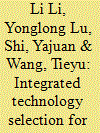| Srl | Item |
| 1 |
ID:
094928


|
|
|
|
|
| Publication |
2010.
|
| Summary/Abstract |
China has set an ambitious target of increasing energy efficiency by 20% and reducing pollution discharges by 10% over the period 2006-2010. Promoting advanced technologies and closing outdated facilities are widely recognized as important measures to achieve these targets. These actions can also indirectly decrease release of polychlorinated dibenzo-p-dioxins (PCDDs) and polychlorinated dibenzofurans (PCDFs). The objectives of this paper are to identify and quantify reductions of PCDD/F emissions to air due to measures such as phasing out of obsolete facilities in the four most energy-intensive industrial sectors. Reductions in PCDD/F emissions from power generation were estimated to be 7, 33 and 38 g I-TEQ in 2006, 2007 and 2008, respectively. For the cement industry, reductions were estimated to be 680 g I-TEQ between 2007 and 2008, and 740 g I-TEQ between 2009 and 2010. For the iron and steel industry, the reduction was estimated to be 113.3 g I-TEQ over the period 2007-2010, which includes 76.6 g I-TEQ in 2007. For the coke industry, the reduction was estimated to be 68 g I-TEQ in 2007 and 62 g I-TEQ in 2008.
|
|
|
|
|
|
|
|
|
|
|
|
|
|
|
|
| 2 |
ID:
118835


|
|
|
|
|
| Publication |
2013.
|
| Summary/Abstract |
Energy conservation and PAHs (polycyclic aromatic hydrocarbon) control are two challenges for the iron and steel industry, especially where the industry has developed at high speed. How to select appropriate technologies to improve energy efficiency and control pollution from PAHs simultaneously is encountered by both the researchers and the decision makers. This study sets up a framework on technology selection and combination which integrates technology assessment, multiple objective programming and scenario analysis. It can predict proper technology combination for different emission controls, energy conservation targets and desired levels of production. An iron and steel factory in Southwestern China is cited as a case. It is shown that stricter PAHs control will drive the transformation from process control technology to alternative smelting technology. In low PAHs limit, 25% energy reduction is a threshold. Before inclusion of a restraint on energy consumption at 25% reduction, PAHs emission is the key limiting factor for the technology selection; while after inclusion of this restraint, energy consumption becomes the key limiting factor. The desired level of production will also influence the technology selection. This study can help decision makers to select appropriate technologies to meet the PAHs control objectives and energy conservation strategies in energy-intensive industries.
|
|
|
|
|
|
|
|
|
|
|
|
|
|
|
|